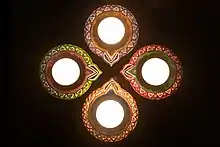Diya (lamp)
A diya, diyo, deya,[1] deeya, dia, divaa, deepa, deepam, deep, deepak or saaki (Sanskrit: दीपम्, romanized: Dīpam) is an oil lamp made from clay or mud with a cotton wick dipped in oil or ghee. These lamps are commonly used in the Indian subcontinent and they hold sacred prominence in Hindu, Sikh, Buddhist, and Jain prayers as well as religious rituals, ceremonies and festivals including Diwali.[2]



Traditional use
Clay diyas are symbolically lit during prayers, rituals, and ceremonies; they are permanent fixtures in homes and temples. The warm, bright glow emitted from a diya is considered auspicious, regarded to represent enlightenment, prosperity, knowledge and wisdom. Diyas represent the triumph of light over dark, good over evil with the most notable example of this being on the day of Diwali. Diwali is celebrated every year to celebrate the triumph of good over evil as told in the Hindu epic, the Ramayana. Diwali marks the day Rama, Sita, and Lakshmana returned home to Ayodhya after 14 years in exile, after the defeat of Ravana. According to tradition, to welcome Rama, Sita, and Lakshmana home, the citizens of Ayodhya are said to have lit up the streets with diyas. They are regarded to be associated with Lakshmi in Hindu iconography and worship.[3]
Traditionally, diyas are lit every morning within Hindu temples.
Festivals
- Diwali: The lighting of diyas forms a part of celebrations and rituals of the important day in the Hindu calendar. Houses are decorated with small diyas placed at boundaries and entrances.[4] In fact, the name of Diwali is derived from the Sanskrit word Deepavali, which means the row of lights ("deep" means Diya and "avali" means row).[5]
 Tealight Diyas used for decoration during Diwali
Tealight Diyas used for decoration during Diwali - Karthikai Deepam: Diyas, also known as deepam in Tamil Nadu, can be lit, especially during the Kartikai Deepam.
Worship and prayers
Lit diyas that are placed before deities during prayer in temples and then used to bless worshippers is referred to as an arati.
A similar lamp called a butter lamp is used in Tibetan Buddhist offerings as well.
Types

In terms of the choice of material, the kiln fired earthenware lamps followed by the metallic lamps with multiple wicks, mostly of brass known as Samai, are the most common, though other materials are also used such as patravali floating lamp made from leaves or permanent lamps made of stones.
In terms of wick design, diyas with one wick are most common, followed by the two wick style, but other variations such as four, five or seven wick lamps are also made.
In terms of overall lamps design, the ornamental lamps come in various designs. The iconic Nachiarkoil lamp, also known as "Annam lamp", is produced exclusively in by the Pather (Kammalar) community in Nachiyar Koil of Tamil Nadu.[9][10]
See also
- Other lamps
- Related topics
References
- Sacred Places of a Lifetime. Washington DC: National Geographic Society. 2008. p. 270. ISBN 978-1-4262-0336-7.
- "Diwali: Significance of a Diya". Zee Media Corporation Ltd. Retrieved 19 July 2013.
- Stutley, Margaret (9 April 2019). The Illustrated Dictionary of Hindu Iconography. Routledge. p. 390. ISBN 978-0-429-62425-4.
- The Asiatic Journal and Monthly Register for British and Foreign India, China, and Australia Front Cover Parbury, Allen, and Company, 1834, page 346
- Tej K. Bhatia and Naresh Sharma "The Routledge Intermediate Hindi Reader", Routledge, 2015 ISBN 1317962850, 9781317962854
- "Rituals after death as per Hinduism". Hindu Janajagruti Samiti. Retrieved 25 April 2018.
- "Introduction to death & dying". srimatham.com. Retrieved 25 April 2018.
- "Hindu Death Rites". Asian Cremation USA. Retrieved 25 April 2018.
- PM Narendra Modi gifts Xi Jinping Annam lamp, Times of India, 11 October 2019.
- Largest collection of traditional diyas (lamps), World Records India, 9 November 2020.

.jpg.webp)
